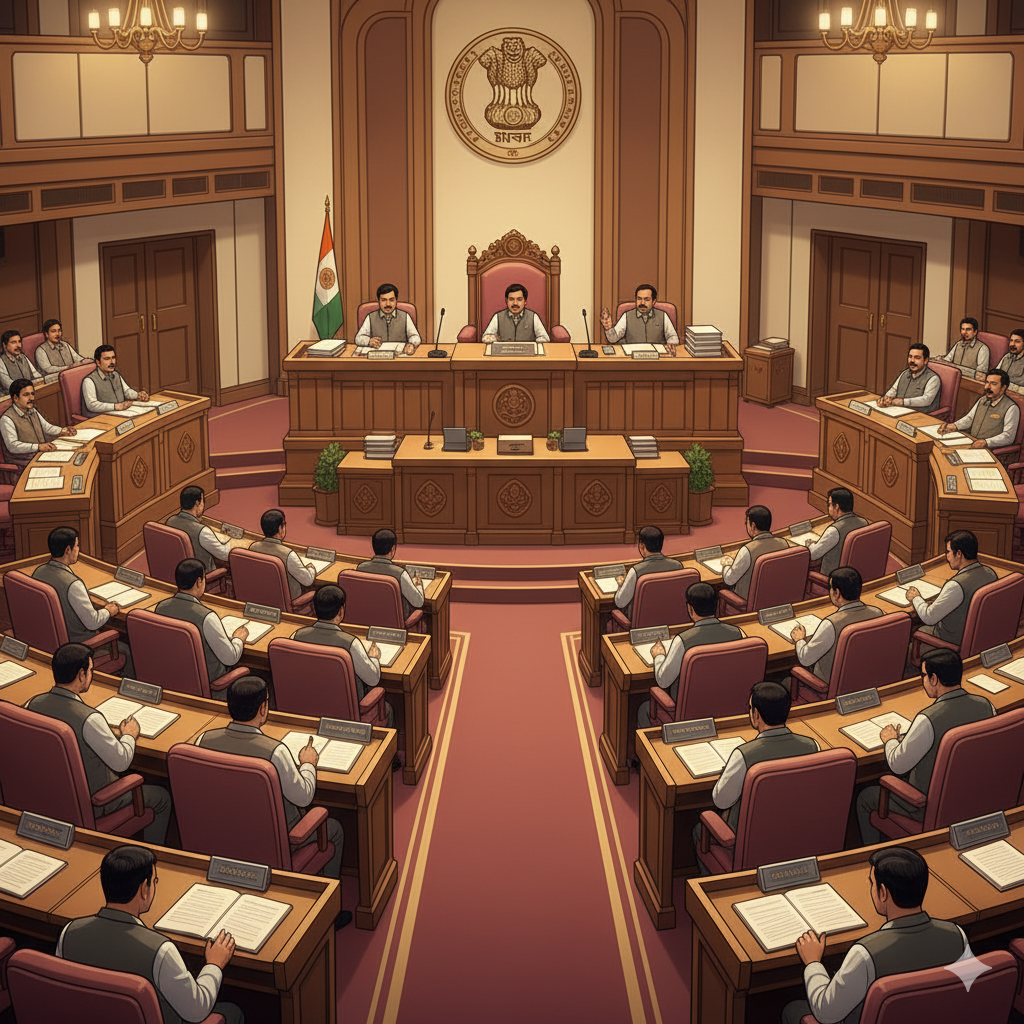Introduction: What the Bihar Vidhan Sabha Is and Why It Matters
The Bihar Vidhan Sabha is the beating heart of the state’s democracy—it’s where elected folks from every corner of Bihar come together to hammer out the laws, budgets, and policies that touch our everyday lives. It’s not just some stuffy hall with big speeches; it’s where the big decisions get made—think funding for schools, fixing those pothole-riddled roads, hashing out health programs, or tweaking welfare schemes that help families get by. If you’re a Bihar resident wondering how to make your voice heard—whether through voting, firing off a petition, catching a live session, or bugging your MLA—getting the lowdown on how the Bihar Vidhan Sabha works is your ticket to being a real player in the civic game. This guide is your one-stop shop, diving into the nuts and bolts of the assembly with a human touch, from its history and setup to practical tips for staying in the loop and making a dent.
A Concise History: How the Bihar Vidhan Sabha Evolved
The Bihar Vidhan Sabha didn’t just pop up overnight—it’s got roots that stretch back to when Bihar was carved out from Bengal and Orissa under colonial rule. Back then, it was more of a small council for local bigwigs, but it’s grown into this full-blown democratic powerhouse that mirrors Bihar’s vibrant mix of languages, cultures, and regions. After independence, the setup solidified into what we’ve got now: a bicameral system where the Vidhan Sabha, the elected lower house, teams up with the Vidhan Parishad, the upper chamber. The grand old building in Patna where it all goes down isn’t just a workplace—it’s a piece of Bihar’s story, with architecture that makes locals proud and visitors curious. Every debate inside those walls carries the weight of that history, tying yesterday’s struggles to today’s policies.
Composition and Numbers: Who Sits in the House
The Bihar Vidhan Sabha is made up of 243 MLAs, each one representing a slice of the state’s map—your neighborhood, basically. These folks get elected for a five-year stint, unless something shakes things up early, like a dissolution. Seats are divvied up across constituencies, with some reserved for Scheduled Castes and Tribes based on population spread. Why does this matter? Because those numbers decide who’s got the muscle in the house—party strengths, coalition deals, and how smoothly (or not) a bill sails through. The lineup also shapes who gets on key committees, who sets the daily agenda, and which voices get the loudest mic. It’s the math behind the politics, and it’s where Bihar’s diversity gets a seat at the table.
The Legislative Cycle: From Draft to Law
Turning an idea into a law in the Bihar Vidhan Sabha is like choreographing a dance with a lot of steps. It starts with someone—maybe a minister or an MLA—tossing out a bill. That draft gets debated, picked apart, and often sent to a committee for a deep dive before the whole house votes on it. Money bills, the ones about taxes or spending, follow a tighter script, with the Vidhan Sabha holding the reins since the upper house can’t mess with them too much. The speaker gets to call whether a bill’s about money, which is a big deal because it sets the pace for how fast it becomes law. Committees are the unsung heroes here—they dig into details, call in experts, tweak clauses, and churn out reports that steer the final showdown. It’s a balance of hustle and careful thought, and when it’s done right, you get laws that actually make sense for Bihar.
Sessions, Calendar, and Day-to-Day Conduct
The Bihar Vidhan Sabha gets down to business in three main chunks each year: the budget session (where the money talk happens), the monsoon session (rainy days, heated debates), and the winter session (cooler heads, still spicy). These are when the big stuff—budgets, policies, fiery Q&As with ministers—gets hashed out. The speaker’s in charge, keeping things civil, deciding who talks, and making sure the house doesn’t turn into a shouting match. Outside these sessions, committees keep grinding, question hours dig into government slip-ups, and now and then, a quick special sitting pops up for urgent stuff. This rhythm sets the pace for when your petition might get an answer or when a big reform gets the green light, so it’s worth knowing the calendar if you’re keeping tabs.
The Speaker and the Chair: Neutral Arbiter or Political Actor?
The speaker of the Bihar Vidhan Sabha is elected by the MLAs and is supposed to be the fair referee—calling the shots on what motions make the cut, when debates fire up, and whether a bill’s about money or not. Those calls can tilt the game, making the speaker a linchpin in how smoothly (or not) the house runs. A good speaker keeps things above board, calming tempers and moving business along; a partisan one can stir up chaos, stalling progress. They also run the assembly’s backstage crew—the secretariat—making sure the paperwork and logistics don’t derail the show. It’s a role that’s half umpire, half manager, and when it’s done right, it keeps the Bihar Vidhan Sabha a place where ideas, not egos, win.
Committees: Where Detailed Work Really Happens
The real heavy lifting in the Bihar Vidhan Sabha often happens away from the spotlight, in committees. These smaller groups of MLAs tackle everything from department budgets to specific bills, grilling officials, hearing from experts, and hashing out reports that shape what the full house decides. You’ve got standing committees for sectors like health or education, plus ones like public accounts that sniff out financial waste, and ad hoc teams for hot-button issues. With the assembly’s packed schedule, committees are like extra arms—they dig deeper, gather hard evidence, and make sure debates aren’t just hot air. The secretariat keeps this machine humming, churning out notices and reports that turn talk into action. When committees click, the Bihar Vidhan Sabha’s laws get sharper and its oversight gets teeth.
The Vidhan Sabha Building and Precinct: Heritage, Accessibility, and Symbolism
The Bihar Vidhan Sabha’s home in Patna isn’t just a building—it’s a piece of the state’s soul. This historic structure, with its old-school grandeur, is where laws are born and democracy breathes. But it’s not just about vibes; the layout matters—where the public galleries sit, how easy it is to drop in with a petition, or whether the press can cover debates without jumping hoops. A welcoming setup, with clear signs and open doors, screams transparency and invites folks—students, curious locals, you name it—to see their government in action. Keeping the place spruced up, balancing heritage with modern tweaks, shows how much Bihar values this hub of civic life. It’s more than bricks; it’s where the state’s story gets written.
Electoral Dynamics and the Assembly’s Political Life
Elections are the pulse of the Bihar Vidhan Sabha, deciding who fills those 243 seats and what fights dominate the floor. The house mirrors the state’s political chessboard—alliances shift, parties rise and fall, and sometimes a lone independent MLA can tip the scales in a tight race. Question hours turn into opposition ambushes, spotlighting government fumbles, while the ruling side pushes bills as shiny reform wins. Big laws often drop before elections to woo voters, and debates can feel like campaign rallies. Getting the political undercurrents—why a bill’s timed the way it is or who’s got leverage—helps you see the Bihar Vidhan Sabha not just as a law factory but as a stage where Bihar’s future gets scripted.
How the Assembly Holds the Executive to Account
One of the Bihar Vidhan Sabha’s biggest jobs is keeping the government—think the Chief Minister and their crew—in check. MLAs do this through question hour, peppering ministers with pointed queries; calling attention motions to flag urgent messes; no-confidence votes to shake things up; and committee reports that dive deep into spending or policy flops. When the opposition’s on fire, the media’s watching, and citizens are tuned in, these tools can expose slip-ups, spark fixes, or force the government to rethink a bad move. It’s the Bihar Vidhan Sabha flexing its muscle to make sure the state’s bosses answer to the people’s reps, not just their own agendas.
Citizen Access and Public Participation
The Bihar Vidhan Sabha isn’t some ivory tower—it’s built to be your space too. You can show up to watch sessions, file petitions through your MLA or the secretariat, or dig into what’s cooking via online updates. Some states, Bihar included, are getting better at posting bills, reports, and schedules online, which makes it easier for you or a journalist to keep tabs and call out nonsense. At the local level, MLAs hold constituency meets—think mini town halls—where you can air grievances or push for action. Public hearings on big bills, though not always common, are another way to weigh in. The more you know your MLA and the assembly’s rhythm, the better you can nudge the system to work for you.
Rules, Privileges, and Ethical Conduct
The Bihar Vidhan Sabha runs on a tight set of rules—think standing orders that cover everything from how long you can ramble in a speech to what happens if someone steps out of line. These keep the house dignified and protect MLAs’ rights to speak freely. Privilege committees handle any breaches, like if someone disrespects the process, while ethics rules set the bar for acting right. When everyone plays fair, debates stay sharp and productive; when they don’t, things can grind to a halt. Clear, open rules let you judge if your reps are living up to the job, making the Bihar Vidhan Sabha a place where trust hinges on conduct, not just promises.
Bills That Changed Bihar: Examples of Legislative Impact
The Bihar Vidhan Sabha’s fingerprints are all over the state’s big shifts—land reforms that reshaped who owns what, education laws that got more kids in classrooms, labor rules that set fairer terms, and welfare programs that put food on tables. Even the quieter bills—tweaks to regulations or funding rules—can unclog bottlenecks, making government services hum. When the assembly passes something with broad buy-in, it’s usually a sign it’s hitting a real need; when debates get heated, you’re seeing Bihar’s priorities clash and evolve. Tracking these laws shows you what’s driving the state and where it’s headed.
The Media, Transparency, and Public Record
The Bihar Vidhan Sabha is a goldmine for journalists—it’s where policy fights and political drama spill out in real time. Live streams, published bills, and committee reports give the media (and you) raw material to unpack what’s going on. When the assembly’s open about its work—think webcasts, searchable records, clear calendars—it cuts through the fog of rumors and lets reporters tell fact-based stories. For you, the citizen, or a researcher digging into Bihar’s policy past, those archives are like a time machine, showing why decisions were made and how they’ve shaped the state. A transparent Bihar Vidhan Sabha doesn’t just make laws; it builds trust by letting you see the gears turning.
Challenges the Vidhan Sabha Faces Today
No institution’s perfect, and the Bihar Vidhan Sabha’s got its share of hurdles. Time’s always tight—big laws sometimes get rushed through without enough debate. Committees could use more brainpower, like better research or expert input, to sharpen their work. Getting everyday folks, especially from marginalized corners, truly heard is tough when participation channels aren’t always wide open. Tech upgrades, like digitizing old records or beefing up constituency services, lag in spots. Fixing these means doubling down on the nuts and bolts—more secretariat muscle, smarter reforms, and a focus on quality laws over just churning them out.
Institutional Reforms and Modernization Opportunities
There’s a real buzz about leveling up the Bihar Vidhan Sabha—think beefier research teams to arm MLAs with facts, digitizing dusty archives for easy access, and pumping up committees with technical know-how. Training MLAs on crafting bills or using oversight tools can make debates less posturing, more problem-solving. Tech like live streams or mobile-friendly debate summaries can bring the house closer to you. These tweaks don’t just sound good—they build a Bihar Vidhan Sabha that’s more open, sharper, and tuned to what Bihar needs, turning trust into better laws.
How MLAs Can Maximize Constituency Impact
For an MLA in the Bihar Vidhan Sabha, it’s a balancing act: crushing it in Patna’s debates while being a rockstar back home. The good ones prep hard for sessions, use committee gigs to dig into issues, and follow through on questions they raise. Locally, they’re out there meeting folks, pushing state schemes to land where they’re needed, and keeping ears open for feedback. Teaming up with local councils or district officials to match state plans with village realities—that’s where the magic happens. It’s not just about passing laws; it’s about making sure those laws hit the ground running in your backyard.
How to Follow and Engage with the Vidhan Sabha
Want to keep up with the Bihar Vidhan Sabha? Start by finding your MLA’s contact and signing up for official updates—calendars, bills, or reports often pop up online. Swing by a session if you’re in Patna, file a petition through your MLA’s office, or use RTI to pull records for clarity. Groups like NGOs can break down complex debates into bite-sized bits, helping you stay in the know. The more you track what’s cooking in the assembly, the better you can push your rep to deliver or call out when they don’t.
Comparative Perspective: Lessons from Other Assemblies
Peeking at how other state legislatures do it can spark ideas for the Bihar Vidhan Sabha. Some have crack research teams dishing out neutral briefings for all members, others hold regular public hearings to get real input on bills. Borrowing tricks like better briefings, routine consultations, or plain-language explainers could make Bihar’s assembly sharper. These aren’t pie-in-the-sky fixes—they’re practical moves that boost accountability and make the Bihar Vidhan Sabha a better mirror of what the state needs.
The Relationship Between the Vidhan Sabha and Local Governance
The Bihar Vidhan Sabha’s laws set the stage for how cities and villages run—think tax rules, grants, or decentralization plans that decide what local councils can do. Good laws sync state goals with local realities, speeding up services like water or schools; sloppy ones leave gaps that frustrate everyone. MLAs bridge this, turning state policies into local wins by working with district officials or panchayats. When the Bihar Vidhan Sabha nails this, you feel it—roads get fixed, funds flow smoother, and villages aren’t left guessing.
Civic Education: Teaching Citizens About the Assembly
Getting kids and grown-ups alike clued in on the Bihar Vidhan Sabha is a democracy booster. Schools can run mock assemblies, colleges can host tours, and civic groups can whip up simple guides to how laws get made. When you know who’s representing you and how the process works, you’re more likely to speak up—whether it’s a petition or a public hearing. It’s also a shield against fake news, grounding you in what the Bihar Vidhan Sabha can actually do and where it’s got limits. Knowledge is power, plain and simple.
Future Outlook: Sustaining a Deliberative Vidhan Sabha
The Bihar Vidhan Sabha’s got a shot at being a real powerhouse if it keeps building its chops. More research muscle, open public channels, stronger committees, and slick digital tools can make it a place where debates dig deep and laws hit home. It’s a living thing, shaped by the MLAs who show up, the staff who keep it running, and the folks like you who demand better. Investing in that triangle—reps, support, citizens—is how the Bihar Vidhan Sabha stays a true voice for Bihar’s dreams and needs.
FAQs — Focused on the Bihar Vidhan Sabha
What is the Bihar Vidhan Sabha and how is it constituted?
It’s the state’s elected lower house, with 243 MLAs picked from constituencies for five years, unless dissolved early, representing Bihar’s diverse voters.
How are sessions of the Bihar Vidhan Sabha scheduled?
Three big ones—budget, monsoon, winter—plus committee work and pop-up sittings for urgent stuff, setting the pace for laws and answers.
Who presides over the Bihar Vidhan Sabha and what’s the speaker’s role?
The speaker, voted in by MLAs, runs sessions, keeps order, tags bills, and oversees the secretariat, aiming to stay fair but packing political clout.
What are the main functions of the Bihar Vidhan Sabha?
It crafts laws, approves budgets, grills the government through questions and motions, and uses committees to dive deep into policies and spending.
How can citizens access proceedings or participate in the legislative process?
Show up for sessions, check online for bills or reports, petition via MLAs or the secretariat, and lean on NGOs or RTI for transparency.
How do committees in the Bihar Vidhan Sabha work and why are they important?
Small MLA teams dig into bills, budgets, or issues, pulling in experts and crafting reports that shape debates—extending the house’s reach and smarts.
What is the role of the Bihar Vidhan Sabha building in Patna?
It’s the hub for law-making and a civic landmark, with galleries and spaces that, when open, invite folks to see democracy up close.
Where can I find official information or committee reports from the Bihar Vidhan Sabha?
The secretariat posts notices, reports, and records online—your go-to for the real deal on what’s happening in the house.
Can the Bihar Vidhan Sabha be dissolved before five years?
Yep, usually on the Chief Minister’s call, triggering fresh elections to reset the house.
How do MLAs use the Bihar Vidhan Sabha to address local issues?
They raise questions, push motions, join committees, and steer state schemes to fix local problems, bridging Patna to your village.
Closing Thoughts
The Bihar Vidhan Sabha is more than a law factory—it’s where Bihar’s hopes, gripes, and plans get hashed out. Its strength lies in how well MLAs prep, how deep committees dig, and how open it is to your scrutiny. Boosting research, empowering committees, and throwing doors wide with digital tools can make it a true people’s house. For anyone in Bihar—citizen, journalist, or public servant—tuning into the Bihar Vidhan Sabha means owning a piece of the state’s future. Stay curious, stay engaged, and let’s make it work for us all.
(Word count: approximately 3,050)








